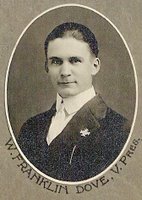 Not generally famous for its scientific masterminds, Maine occasionally surprises the rest of the world with inventions and improvements seemingly from out of the blue (it's our little secret -- there are a lot of smartypants living here).
Not generally famous for its scientific masterminds, Maine occasionally surprises the rest of the world with inventions and improvements seemingly from out of the blue (it's our little secret -- there are a lot of smartypants living here).Back in May of 1936, Dr. W. Franklin Dove, a biologist at the University of Maine, published a journal article titled "Artificial Production of the Fabulous Unicorn" in the Scientific Monthly (Vol. 42, pgs 431-436). This article detailed his experiments in forming an artificially created unicorn. To accomplish this, he performed surgery on a day-old Ayrshire bull-calf, in which the calf's hornbuds were removed and reinserted in a single position at the center of the calf's forehead.
 As The Skeptic reported, "Instead of the pair of curved horns typical of Ayrshires, this animal grew a single, very straight horn, curving slightly upwards at its tip. And, this horn was pale gray at its base and black at its tip. The similarity to the ancient descriptions of mythical Unicorns was uncanny." (Volume 14, No. 1, 1994)
As The Skeptic reported, "Instead of the pair of curved horns typical of Ayrshires, this animal grew a single, very straight horn, curving slightly upwards at its tip. And, this horn was pale gray at its base and black at its tip. The similarity to the ancient descriptions of mythical Unicorns was uncanny." (Volume 14, No. 1, 1994)The same Skeptic article mentions the possibility that this was the same technique used by African Dinkas and Karrirs on their cattle, and by the Nepalese, presumably to mark the leaders of their herds.
An interesting note on the results of this process on Dr. Dove's bull is reported at unicorngarden.com:
Dr Dove's Unicorn bull became the leader of its herd and was very rarely challenged by other males. Which is not altogether surprising if you think about it. When bulls charge each other the main aim (as with male deer) is to crack skulls until one or other can take no more. Charging towards an enemy who has a spike aimed right between your eyes is a different game altogether. So effective was the single horn that one almost wonders why evolution did not do Dr Dove's work for him. An interesting side effect of the experiment was the nature of the bull's temperament. Being secure in his strength led him to become unusually gentle and mild mannered, echoing what has so often been said of the true Unicorn's nature.
Who knew the unicorn and science could co-exist so peacefully, and in Maine of all places?

On February 7th, 1984, Timothy G. Zell (shown here in a recent portrait photo) patented a variation on this procedure, the details of which can be found here, where it won a Wacky Patent of the Month award. This commercialization of the process was instigated by Zell (a.k.a. "Otter" or "Oberon" G'Zell or Zell-Ravenheart, founder of the Church of All Worlds) and his wife Morning Glory. Source
For more on the Church, please click here. Pretty interesting stuff. The Church is gathered as a neo-pagan earth religion, taking inspiration from Heinlen's sci-fi classic, Stranger in a Strange Land. The Church's official site is located here. Quit your snickering over there, you!
No comments:
Post a Comment